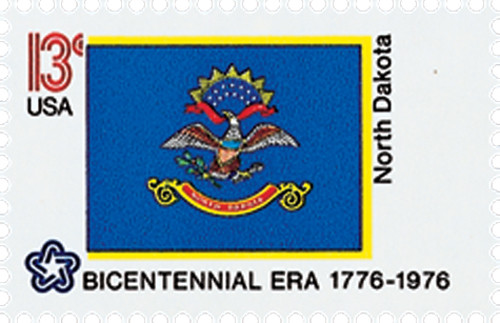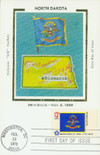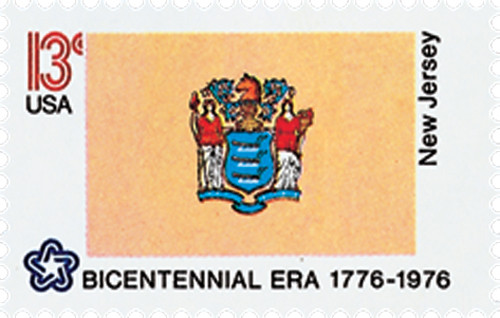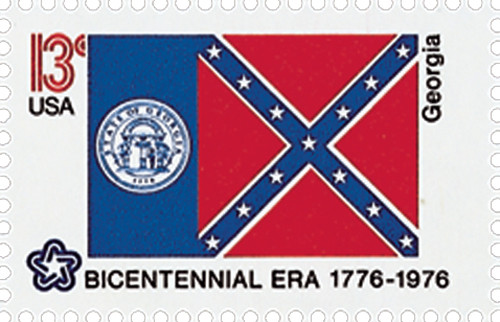
# 1671 - 1976 13c State Flags: North Dakota
U.S. 1671
1976 North Dakota
State Flags
American Bicentennial Series
• First time a sheet 50 had all different stamp designs
• Part of the American Bicentennial Series
Stamp Category: Commemorative
Series: American Bicentennial Series
Value: 13¢ First-class postage rate
First Day of Issue: February 23, 1976
First Day City(s): Washington, DC
Quantity Issued: 8,720,100 (panes of 50)
Printed by: Bureau of Engraving and Printing
Printing Method: Photogravure
Format: Sheet of 50
Perforations: 11
Why the stamp was issued:
The United States Postal Service celebrated the American Bicentennial with a full pane of the Union’s fifty state flags.
About the stamp design:
The North Dakota State Flag is significantly shorter than most flag and state code says that the flag must be made out of blue silk or another material that can hold up in the elements. On the blue field is an eagle holding an olive branch, symbolizing peach, in one talon and arrows, symbolizing the ability to defend one’s right, in the other. There is a ribbon in the eagle’s beak that says, “E Pluribus Unum,” which means many uniting as one referring to the United States. The 13 stars above the eagle and a shield on the eagle with 13 stripes represent the first 13 states. Below the eagle is a red scroll that says North Dakota.
About the printing process:
Printed by the Bureau of Engraving and Printing on their seven-color Andreotti gravure press (601) which was their work horse for multicolored stamps.
About the American Bicentennial Series:
In the 1970s, America celebrated its 200th anniversary with hundreds of national events commemorating the heroes and historic events that led to our nation’s independence from Great Britain. The U.S. Postal Service issued 113 commemorative stamps over a six-year period in honor of the U.S. bicentennial, beginning with the American Revolution Bicentennial Commission Emblem stamp (U.S. #1432). As a group, the Bicentennial Series chronicles one of our nation’s most important chapters, and remembers the events and patriots who made the U.S. a world model for liberty.
Several of the stamps honored colonial life – craftsmen and communication. Other stamps honored important battles including Lexington and Concord, Bunker Hill, and Saratoga. Significant events such as the Boston Tea Party, the meeting of the First Continental Congress, and the Declaration of Independence were featured as well. The stamps also honored many significant people such as George Washington, Sybil Ludington, Salem Poor, and the Marquis de Lafayette.
Many of the stamps feature classic artwork. For instance, the set of four souvenir sheets picture important events recreated by noted artists such as John Trumbull. The Bicentennial Series also includes an important US postal first – the first 50-stamp se-tenant – featuring all 50 state flags. The format proved to be popular with collectors, and has been repeated many times since.
The American Bicentennial Series is packed with important US history – it tells the story of our nation’s fight for independence through stamps.
History the stamp represents:
On November 2, 1889, North and South Dakota became our 39th and 40th states.
Two American Indian tribes lived in North and South Dakota before the arrival of Europeans – the Arikara and the Cheyenne. North Dakota was also home to the Hidatsa and Mandan. In the beginning of the 1700s, the Sioux moved to South Dakota from Minnesota.
Réne-Robert Cavelier, Sieur de La Salle, claimed all the land drained by the Mississippi River system for France in 1682. This included portions of both North and South Dakota. French-Canadian brothers François and Louis-Joseph La Vérendrye were the first whites to reach North and South Dakota.
In 1803, France sold Louisiana to the United States. In 1804, President Thomas Jefferson sent Meriwether Lewis and William Clark on an expedition to explore the Louisiana Territory. They passed through both regions on their way home and established friendly relations with the Indian tribes of the area.
Canadians of Scotch and Irish descent were the first Europeans to attempt a permanent settlement in North Dakota. They settled in Pembina in 1812. In 1818, the U.S. gained control of the northeastern portion of the state through a treaty with Great Britain. This treaty made all of today’s North Dakota U.S. territory. Most of the settlers at Pembina left soon after the treaty was signed, as they wished to remain in British territory.
The first permanent settlement in South Dakota was built in 1817 on the site of Fort Pierre on the Bad River. A French trader, Joseph La Framboise, established the fort. The increased number of Europeans in South Dakota created tensions with the American Indian populations. The Arikara tribe attacked a fur-trading party led by the lieutenant governor of Missouri, General William Ashley. Federal troops were dispatched to punish the tribe.
Congress created the Dakota Territory in 1861. It included the modern states of North and South Dakota, as well as large parts of Montana and Wyoming. In 1863, the Dakota Territory was opened for homesteading. Settlers received free land to live on and improve. Even with the incentive of free land, the territory developed slowly. This was due to poor transportation and fear of Indian attacks.
In the 1860s, conflicts with American Indians prevented rapid settlement of the Dakota Territory. The most significant fighting was during Red Cloud’s War. Red Cloud was a Sioux chief. He opposed the construction of a bridge that was being built to facilitate the mining of gold located in prime Sioux hunting lands. From 1866-68, the Sioux attacked troops and settlers. Finally, the government met their demands and created the Great Sioux Reservation, which included all the land in South Dakota west of the Missouri River.
In 1875, large-scale farming became a profitable business in the Dakota Territory. Eastern corporations and wealthy families established huge wheat farms ranging in size from 3,000 to 65,000 acres. Most of these farms were located in the Red River Valley. These wheat farms earned so much money, they became known as bonanza farms. Improved machinery and orderly methods of planting, harvesting, and marketing were the keys to success of the bonanza farms.
Also in the mid 1870s, a military expedition into the Black Hills, led by Lieutenant Colonel George A. Custer, discovered gold near the present-day town of Custer. In 1876, even larger deposits were found near today’s towns of Lead and Deadwood. These discoveries created a rush of gold prospectors to the area. Lawless mining towns grew in these areas. Deadwood was of particular notoriety. Wild Bill Hickok, Calamity Jane, and other Deadwood citizens grew to become American legends.
The discovery of gold and the availability of excellent farmland attracted many thousands of settlers. Railroads were built. Cattle ranchers were attracted to the area, as there was a huge demand for meat.
During the 1870s, the people of the Dakota Territory began asking Congress to divide their territory into two parts. The main population centers in the territory were in the northeast and southeast and had little contact. Travel between the two was difficult, as the railroads had been laid out in an east-to-west direction. Each group had separate interests and therefore wanted separate government. The border between North and South Dakota was established in February 1889. On November 2, 1889, North and South Dakota were admitted to the union as their own states.
U.S. 1671
1976 North Dakota
State Flags
American Bicentennial Series
• First time a sheet 50 had all different stamp designs
• Part of the American Bicentennial Series
Stamp Category: Commemorative
Series: American Bicentennial Series
Value: 13¢ First-class postage rate
First Day of Issue: February 23, 1976
First Day City(s): Washington, DC
Quantity Issued: 8,720,100 (panes of 50)
Printed by: Bureau of Engraving and Printing
Printing Method: Photogravure
Format: Sheet of 50
Perforations: 11
Why the stamp was issued:
The United States Postal Service celebrated the American Bicentennial with a full pane of the Union’s fifty state flags.
About the stamp design:
The North Dakota State Flag is significantly shorter than most flag and state code says that the flag must be made out of blue silk or another material that can hold up in the elements. On the blue field is an eagle holding an olive branch, symbolizing peach, in one talon and arrows, symbolizing the ability to defend one’s right, in the other. There is a ribbon in the eagle’s beak that says, “E Pluribus Unum,” which means many uniting as one referring to the United States. The 13 stars above the eagle and a shield on the eagle with 13 stripes represent the first 13 states. Below the eagle is a red scroll that says North Dakota.
About the printing process:
Printed by the Bureau of Engraving and Printing on their seven-color Andreotti gravure press (601) which was their work horse for multicolored stamps.
About the American Bicentennial Series:
In the 1970s, America celebrated its 200th anniversary with hundreds of national events commemorating the heroes and historic events that led to our nation’s independence from Great Britain. The U.S. Postal Service issued 113 commemorative stamps over a six-year period in honor of the U.S. bicentennial, beginning with the American Revolution Bicentennial Commission Emblem stamp (U.S. #1432). As a group, the Bicentennial Series chronicles one of our nation’s most important chapters, and remembers the events and patriots who made the U.S. a world model for liberty.
Several of the stamps honored colonial life – craftsmen and communication. Other stamps honored important battles including Lexington and Concord, Bunker Hill, and Saratoga. Significant events such as the Boston Tea Party, the meeting of the First Continental Congress, and the Declaration of Independence were featured as well. The stamps also honored many significant people such as George Washington, Sybil Ludington, Salem Poor, and the Marquis de Lafayette.
Many of the stamps feature classic artwork. For instance, the set of four souvenir sheets picture important events recreated by noted artists such as John Trumbull. The Bicentennial Series also includes an important US postal first – the first 50-stamp se-tenant – featuring all 50 state flags. The format proved to be popular with collectors, and has been repeated many times since.
The American Bicentennial Series is packed with important US history – it tells the story of our nation’s fight for independence through stamps.
History the stamp represents:
On November 2, 1889, North and South Dakota became our 39th and 40th states.
Two American Indian tribes lived in North and South Dakota before the arrival of Europeans – the Arikara and the Cheyenne. North Dakota was also home to the Hidatsa and Mandan. In the beginning of the 1700s, the Sioux moved to South Dakota from Minnesota.
Réne-Robert Cavelier, Sieur de La Salle, claimed all the land drained by the Mississippi River system for France in 1682. This included portions of both North and South Dakota. French-Canadian brothers François and Louis-Joseph La Vérendrye were the first whites to reach North and South Dakota.
In 1803, France sold Louisiana to the United States. In 1804, President Thomas Jefferson sent Meriwether Lewis and William Clark on an expedition to explore the Louisiana Territory. They passed through both regions on their way home and established friendly relations with the Indian tribes of the area.
Canadians of Scotch and Irish descent were the first Europeans to attempt a permanent settlement in North Dakota. They settled in Pembina in 1812. In 1818, the U.S. gained control of the northeastern portion of the state through a treaty with Great Britain. This treaty made all of today’s North Dakota U.S. territory. Most of the settlers at Pembina left soon after the treaty was signed, as they wished to remain in British territory.
The first permanent settlement in South Dakota was built in 1817 on the site of Fort Pierre on the Bad River. A French trader, Joseph La Framboise, established the fort. The increased number of Europeans in South Dakota created tensions with the American Indian populations. The Arikara tribe attacked a fur-trading party led by the lieutenant governor of Missouri, General William Ashley. Federal troops were dispatched to punish the tribe.
Congress created the Dakota Territory in 1861. It included the modern states of North and South Dakota, as well as large parts of Montana and Wyoming. In 1863, the Dakota Territory was opened for homesteading. Settlers received free land to live on and improve. Even with the incentive of free land, the territory developed slowly. This was due to poor transportation and fear of Indian attacks.
In the 1860s, conflicts with American Indians prevented rapid settlement of the Dakota Territory. The most significant fighting was during Red Cloud’s War. Red Cloud was a Sioux chief. He opposed the construction of a bridge that was being built to facilitate the mining of gold located in prime Sioux hunting lands. From 1866-68, the Sioux attacked troops and settlers. Finally, the government met their demands and created the Great Sioux Reservation, which included all the land in South Dakota west of the Missouri River.
In 1875, large-scale farming became a profitable business in the Dakota Territory. Eastern corporations and wealthy families established huge wheat farms ranging in size from 3,000 to 65,000 acres. Most of these farms were located in the Red River Valley. These wheat farms earned so much money, they became known as bonanza farms. Improved machinery and orderly methods of planting, harvesting, and marketing were the keys to success of the bonanza farms.
Also in the mid 1870s, a military expedition into the Black Hills, led by Lieutenant Colonel George A. Custer, discovered gold near the present-day town of Custer. In 1876, even larger deposits were found near today’s towns of Lead and Deadwood. These discoveries created a rush of gold prospectors to the area. Lawless mining towns grew in these areas. Deadwood was of particular notoriety. Wild Bill Hickok, Calamity Jane, and other Deadwood citizens grew to become American legends.
The discovery of gold and the availability of excellent farmland attracted many thousands of settlers. Railroads were built. Cattle ranchers were attracted to the area, as there was a huge demand for meat.
During the 1870s, the people of the Dakota Territory began asking Congress to divide their territory into two parts. The main population centers in the territory were in the northeast and southeast and had little contact. Travel between the two was difficult, as the railroads had been laid out in an east-to-west direction. Each group had separate interests and therefore wanted separate government. The border between North and South Dakota was established in February 1889. On November 2, 1889, North and South Dakota were admitted to the union as their own states.


















